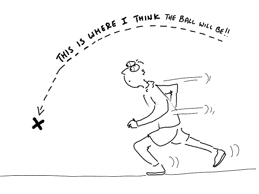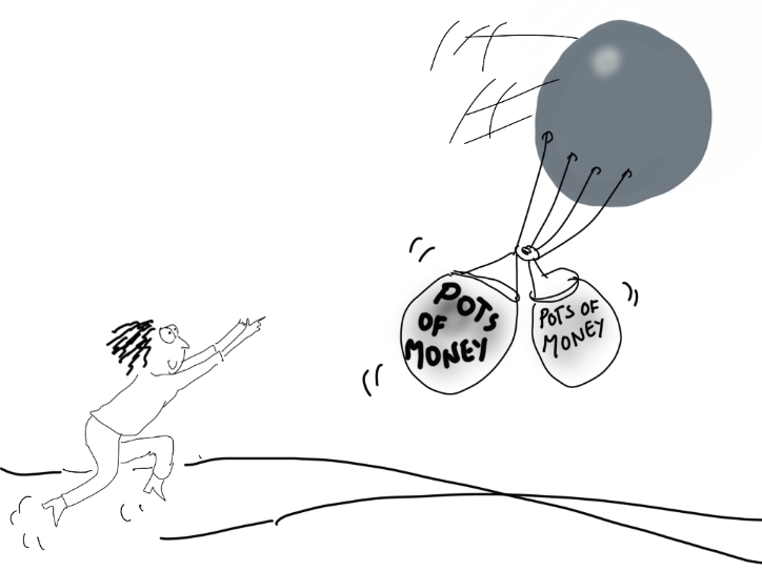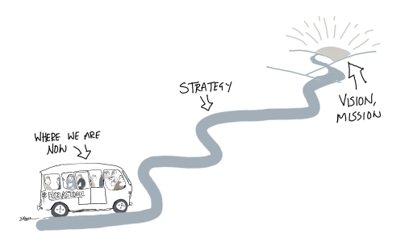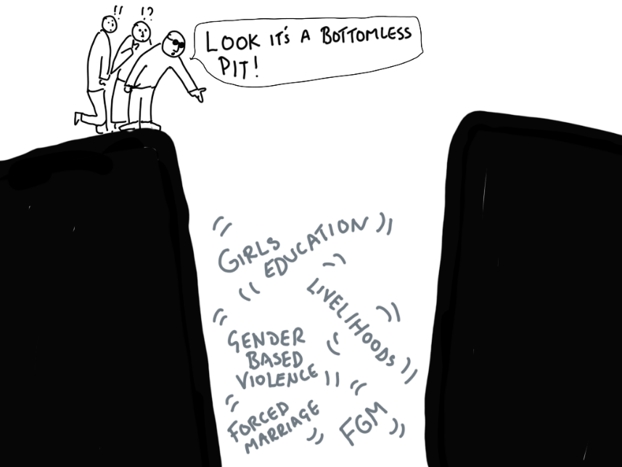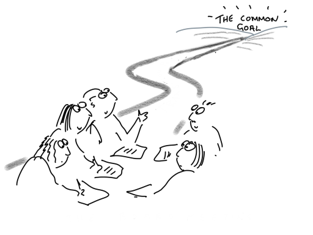Section 02: What is strategic planning?
2.1: What is strategy?
Strategy is a clear and agreed direction of travel – a simple unifying idea of where we are heading. Strategy is like the path that takes us from where we are now to where we want to be: achieving the mission of the organisation at a particular time.
The best footballers run to where they think the ball will be, not where it is at the moment. It is the same with strategy. We move in the direction of where we think the situation will be tomorrow, not what it is like today.
Many NGOs face strategy challenges as they encounter a bottomless pit of need. They often find themselves over-stretched, trying to do too many things, and ending up doing everything poorly. They may start off in girls’ education, but then realise that to make a long term difference they also have to address health… and gender-based violence… and forced marriage… and livelihoods. Everything is inter-connected, so the list goes on.
When the contexts NGOs work in are turbulent, disrupted and uncertain, setting a long term direction of travel not an easy task for NGOs. Climate change and the digital revolution are powerful accelerants. To remain relevant and effective, NGOs have to change as fast as their environments are changing. This requires constant learning and adaptation. Otherwise they run the risk of becoming stuck in past models and ways of working that may have been effective in the past, but work less well today.
Strategy is also a challenge when funding sources are volatile. NGOs may feel they have to shift direction to align with constantly changing funder priorities. For the many smaller NGOs that operate a shoestring, survival may be at stake. They find themselves unable to say ‘no’ to anyone who will give them money – a condition known as strategic delinquency.
2.2 What is strategic planning?
If strategy is a long-term direction of travel, strategic planning is the process of making and documenting these choices about strategy. Strategic planning should make clear and often hard decisions about direction and prioritise resource allocation.
A strategic plan should not simply add new activities to what an NGO is already doing resulting in a ‘shopping list’ of activities. It identifies what the organisation will do differently; do more of and do less of. It is not necessarily about doing more, it is about doing better. The best strategic plans highlight what the NGO is not going to do in future.
This directional, ‘big picture’ strategic plan is not the same as a detailed operational plan. An operational plan puts the strategic direction into practical, bite-sized chunks. It focuses on shorter term goals, usually over 12 months, detailing core activities; who will do what; by when; what resource it will need, and how success will be measured.
Strategic planning is the process of making clear - and often hard - decisions about the chosen direction.
Strategic plans should NOT be shopping lists.
Growth is not an end in itself – achieving one’s mission is.
2.3 How can strategic planning help?
A strategic plan is a communication tool. It can help staff, trustees, partners, donors, understand the aspired direction of travel.
The process of developing a strategic plan - consulting and agreeing what to put on paper - can be extremely valuable. It offers the opportunity to:
Clarify identity, purpose and unique contribution;
Reflect back on impact in the past – learning from experience;
Look up to see the big picture for the future;
Lsten to and build better relationships with a variety of stakeholders;
Build teamwork and expertise amongst staff;
Bring coherence to different projects and parts of the organisation;
Prioritise where to focus energies and resources in the future to maximise its potential for achieving its mission.
While strategy may be most familiar in Northern management schools, it is not a foreign concept or imposition. Taking considered decisions about long-term direction is part of every culture, as these proverbs from Malawi show:
“Here delicious things, there delicious things, the monkey goes for them all and falls flat on its back.”
“A dog sitting on a warm veranda does not move despite hearing a roaring lion… It does nothing as the raring gets louder. It ends up being killed.”
2.4 What challenges to face in strategic planning?
Many NGOs do not do strategic planning well. They often miss the vital opportunity to listen actively and creatively to those they exist to serve – to focus on which, of all the activities they are involved in, brings about meaningful change.
Having a strategic plan is not enough. It needs using as a basis for day-to-day decision making and also evolve. Too often strategic plans are not living documents. They are simply ignored, left for dead on the shelf. At other times, they can also be used too rigidly. Rather than learning from experience, NGOs religiously stick to the plan. The plan itself can become the focus, rather than impact on the ground.
Effective strategic planning requires regular reviews and adaptations. In an increasingly volatile and uncertain world, it is hard to predict what will happen in five months time, let alone five years. COVID showed how dramatically and instantly the world can change. So instead of five-year strategic plans, set in stone, strategy must evolve based on learning from practice and periodic analysis of how the external environment is changing.
“Plans are useless, planning is essential.”
In an increasingly uncertain world, NGOs would do well to heed these wise words of President Dwight Eisenhower.
Last updated
